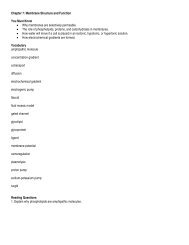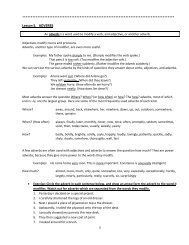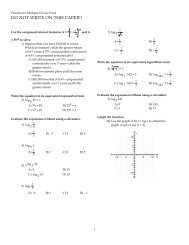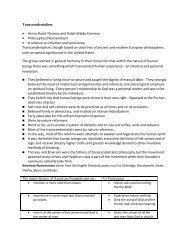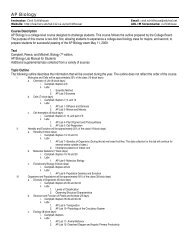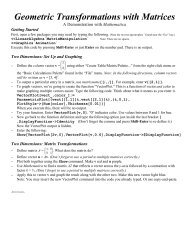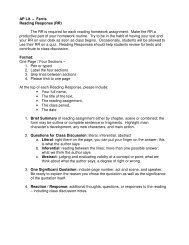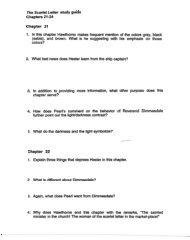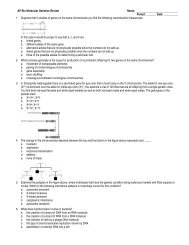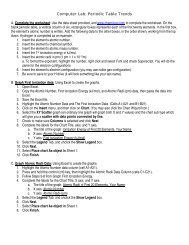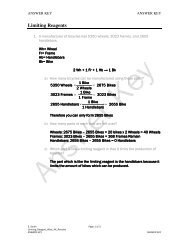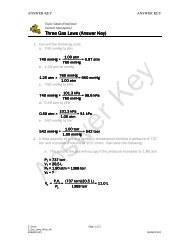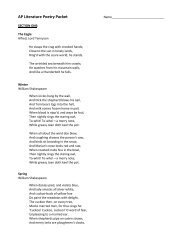Park ? AP Physics B Final Exam Review Problems Name ... - Teacher
Park ? AP Physics B Final Exam Review Problems Name ... - Teacher
Park ? AP Physics B Final Exam Review Problems Name ... - Teacher
Create successful ePaper yourself
Turn your PDF publications into a flip-book with our unique Google optimized e-Paper software.
<strong>Park</strong> – <strong>AP</strong> <strong>Physics</strong> B <strong>Final</strong> <strong>Exam</strong> <strong>Review</strong> <strong>Problems</strong> <strong>Name</strong>: _______________________<br />
The first 10 meters of a 100-meter dash are covered in 2 seconds by a sprinter who starts from<br />
rest and accelerates with a constant acceleration. The remaining 90 meters are run with the same<br />
velocity the sprinter had after 2 seconds.<br />
(a) Determine the sprinter's constant acceleration during the first 2 seconds.<br />
(b) Determine the sprinter's velocity after 2 seconds have elapsed.<br />
(c) Determine the total time needed to run the full 100 meters.<br />
(d) On the axes provided below, draw the displacement vs. time curve for the sprinter.<br />
Additional Free Response Questions<br />
A woman fell 43.9 m from the top of a<br />
building, landing on the top of a metal<br />
ventilator box, which she crushed to a depth<br />
of 46 cm. She survived without serious<br />
injury. What acceleration (assumed<br />
uniform) did she experience during the<br />
collision? How many g's is this? (936<br />
m/s/s; 96 g’s)<br />
A ball of moist clay falls to the ground from<br />
a height of 15.0 m. It is in contact with the<br />
ground for 20.0 ms before coming to rest.<br />
What is the average acceleration of the clay<br />
during the time it is in contact with the<br />
ground? (857 m/s/s)<br />
A dart is thrown horizontally toward the<br />
bull's-eye of a dartboard with an initial<br />
speed of 10 m/s. It hits at a point near the<br />
bottom rim, vertically below the bull's-eye,<br />
0.19 s later. (a) How far from the bull's-eye<br />
did the dart hit? (b) How far away from the<br />
dart board did the thrower stand? (0.18 m;<br />
1.9 m)<br />
A rifle is aimed horizontally at a target 30.5<br />
m away. The bullet hits the target 1.9 cm<br />
below the aiming point. (a) What is the<br />
bullet's time of flight? (b) What is its<br />
muzzle velocity? (0.063 s; 484 m/s)<br />
You throw a ball with a speed of 25.0 m/s at<br />
an angle of 40° above the horizontal directly<br />
toward a wall. The wall is 22 m horizontally<br />
from the release point of the ball. (a) How<br />
long does the ball take to reach the wall? (b)<br />
How far above the release point does the<br />
ball hit the wall? (c) What are the<br />
horizontal and vertical components of its<br />
velocity as it hits the wall? (d) When it hits,<br />
has it passed the highest point on its<br />
trajectory? (1.15 s; 12.0 m; 19.2 m/s and<br />
4.8 m/s; no)<br />
A model rocket is fired vertically and<br />
ascends with a constant vertical acceleration<br />
of 4 m/s/s for 6 s. Its fuel is then exhausted<br />
and it continues as a free-fall particle. (a)<br />
What is the maximum altitude reached? (b)<br />
What is the total time elapsed from takeoff<br />
until the rocket strikes the earth? (101 m; 13<br />
s)
Additional Multiple Choice Questions<br />
Questions 1-8 refer to the following set of speed-time graphs. On your answer sheet, write the<br />
letter(s) of the graph(s) that represent the kind of motion described. There may be more than<br />
one letter for each answer. If there are no graphs for which the description is true, write "none."<br />
1. moving at a constant speed<br />
2. increasing speed in either direction<br />
3. moving in the positive direction<br />
4. moving in the negative direction<br />
5. standing still<br />
6. decreasing speed in either direction<br />
7. moving in the negative direction at a constant speed<br />
8. moving in the positive direction with a changing speed<br />
Questions 9-15 refer to the following set of distance-time graphs. On your answer sheet, write<br />
the letter(s) of the graph(s) that represent the kind of motion described. There may be more than<br />
one letter for each answer. If there are no graphs for which the description is true, write "none."<br />
9. standing still<br />
10. changing speed in either direction<br />
11. increasing speed in either direction<br />
12. moving in the negative direction<br />
13. moving like a freely-falling object in a vacuum<br />
14. decreasing speed toward the origin<br />
15. moving with a constant speed<br />
Continued
A 75 kg person stands on the floor in an elevator at rest.<br />
(a) Draw a free body diagram for the person.<br />
(b) What is the magnitude of the normal force on the person?<br />
(c) The elevator now accelerates upward at 3 m/s/s. What is the new magnitude of the normal<br />
force?<br />
(d) The elevator turns around and accelerates downward at 1 m/s/s. What is the new magnitude<br />
of the normal force?<br />
A car is parked on a hill with a constant slope of 25°. The car’s parking brake is securely set. A<br />
tow truck is pulling the car up the hill. The coefficient of friction between the tires and the road<br />
is 0.8.<br />
(a) Draw a free body diagram for the car.<br />
(b) How much force does the tow truck need to pull with in order to move the car up the hill at a<br />
constant velocity?<br />
(c) The tow truck operator realizes that the car’s brake is on and releases it, allowing the car’s<br />
wheels to roll. The coefficient of friction within the axles is now 0.1. Now how much force<br />
does the tow truck need to pull the car up the hill with a constant velocity?<br />
A 1200 kg sports car is hurtling toward the bottom of a cliff at 25 m/s. It is stopped by the cliffs<br />
in 0.12 seconds. What was the force that the cliff put on the car?<br />
Frank, whose mass is 75 kg, jumps from his house’s balcony (2 meters high). Foolishly, he<br />
holds his body perfectly stiff so that his body strikes the ground like a spear. He jolts to a stop in<br />
only 0.016 seconds. The force bringing Frank to a stop is split between each leg. A tibia can<br />
withstand a shock of 13200 N without breaking. Can Frank walk away from his jump?<br />
You are pulling a 20 kg crate up a 30° incline at constant speed. How large a force parallel to the<br />
incline is needed if the coefficient of friction between incline and crate is 0.3?<br />
Hercules and Xena are in a boat in serpent infested waters when a demon appears in the boat!<br />
Hercules (who has a mass of 75 kg) jumps straight off the front of the boat with a speed of 5 m/s<br />
relative to the water. Xena (who has a mass of 71 kg) simultaneously jumps off the back of the<br />
boat at 1 m/s relative to the water. If the 100 kg boat was initially traveling forward at 3 m/s,<br />
what is its velocity after both heroes jump?<br />
If a 1000-kg car is sent toward a cement wall with a speed of 14 m/s and the impact brings it to a<br />
stop in 0.08 s, with what average force is it brought to rest?<br />
A 300 kg motorboat is turned off as it approaches a dock and it coasts in toward the dock at 0.5<br />
m/s. Isaac, whose mass is 62.0 kg, jumps off the front of the boat with a speed of 3.0 m/s<br />
relative to the water. What is the velocity of the boat after Isaac jumps?<br />
The ACE towing company tows a disabled 1050-kg automobile off the road at a constant speed.<br />
If the tow line makes an angle of 10° with the vertical, what is the tension in the line supporting<br />
the car?<br />
Continued
In the figure below, find the acceleration of the (200 kg) cart that is required to prevent the (5 kg)<br />
block from falling. The coefficient of static friction between the block and cart is 0.4.<br />
A cup of coffee is sitting on a table in an airplane that is flying at a constant altitude and a<br />
constant velocity. The coefficient of static friction between the cup and table is 0.3. Suddenly,<br />
the plane accelerates, its altitude remaining constant. What is the maximum acceleration that the<br />
plane can have without the cup sliding backward on the table?<br />
A student is skateboarding down a ramp that is 6.0 m long and inclined at 18° with respect to the<br />
horizontal. The initial speed of the skateboarder at the top of the ramp is 2.6 m/s. Neglect<br />
friction and find the speed at the bottom of the ramp.<br />
A girl is sledding down a slope that is inclined at 30° above the horizontal. A moderate wind is<br />
aiding the motion by providing a steady force of 105 N that is parallel to the motion of the sled.<br />
The combined mass of the girl and sled is 65.0 kg, and the coefficient of kinetic friction between<br />
the sled and the snow is 0.15. How much time is required for the sled to travel down a 175 m<br />
slope, starting from rest?<br />
A 240 N force is pulling an 85 kg refrigerator across a horizontal surface. The force acts at an<br />
angle of 20° above the surface. The coefficient of kinetic friction is 0.2, and the refrigerator<br />
moves a distance of 8 m. Find (a) The work done by the pulling force, and (b) the work done by<br />
the kinetic frictional force.<br />
In screeching to a halt, a car leaves skid marks that are 65 m long. The coefficient of kinetic<br />
friction between the tires and the road is 0.71. How fast was the car going before the driver<br />
applied the brakes?<br />
When a 0.045 kg golf ball takes off after being hit, its speed is 41 m/s. (a) How much work is<br />
done on the ball by the club? (b) Assume that the force of the golf club acts parallel to the<br />
motion of the ball and that the club is in contact with the ball for a distance of 0.01 m. Ignore the<br />
weight of the ball and determine the average force applied to the ball by the club.<br />
A cyclist approaches the bottom of a gradual hill at a speed of 11 m/s. The hill is 5.0 m high,<br />
and the cyclist estimates that she is going fast enough to coast up and over it without peddling.<br />
Ignoring air resistance and friction, find the speed at which the cyclist crests the hill.<br />
A swing is made from a rope that will tolerate a maximum tension of 800 N without breaking.<br />
Initially, the swing hangs vertically. The swing is then pulled back at an angle of 60° with<br />
respect to the vertical and released from rest. What is the mass of the heaviest person who can<br />
ride the swing?<br />
Continued
A wrecking ball swings at the end of a 10 m cable on a vertical circular arc. The crane operator<br />
manages to give the ball a speed of 6 m/s as the ball passes through the lowest point of its swing<br />
and then gives the ball no further assistance. Friction and air resistance are negligible. What<br />
speed does the ball have when the cable makes an angle of 30° with respect to the vertical?<br />
A square 0.4 m on each side is mounted so that it can rotate about an axis that passes through the<br />
center of the square. The axis is perpendicular to the plane of the square. A force of 15 N lies in<br />
this plane and is applied to the square. What is the magnitude of the maximum torque that such a<br />
force could produce?<br />
One end of a meter stick is pinned to a table, so the stick can rotate freely in a plane parallel to<br />
the tabletop. Two forces, both parallel to the tabletop, are applied to the stick in such a way that<br />
the net torque is zero. One force has a magnitude of 2.0 N and is applied perpendicularly to the<br />
length of the stick at the free end. The other force has a magnitude of 6.0 N and acts at a 30°<br />
angle with respect to the length of the stick. Where along the stick is the 6.0 N force applied?<br />
A uniform plank of length 5.0 m and weight<br />
225 N rests horizontally on two supports,<br />
with 1.1 m of the plank hanging over the<br />
right support. To what distance x can a<br />
person who weighs 450 N walk on the<br />
overhanging part of the plank before it just<br />
begins to tip?<br />
As a car in the Indy 500 is going through a turn at a speed of 98.8 m/s, an accelerometer<br />
measures a centripetal acceleration of 30.0 m/s/s. Determine the radius of the turn.<br />
The maximum tension that a 0.5 m string can tolerate is 14 N. A 0.25 kg ball attached to this<br />
string is being whirled in a vertical circle. What is the maximum speed that the ball can have<br />
(a) at the top of the circle and (b) at the bottom of the circle?<br />
In an exercise apparatus, a spring stretches 0.24 m when a bodybuilder exerts a force of 410 N.<br />
(a) When used vertically to support a 12-kg object, by how much does this spring compress? (b)<br />
If that object is pushed down and allowed to oscillate, what will be the period of oscillation?<br />
In preparation for shooting a ball in a pinball machine, a spring (k = 675 N/m) is compressed by<br />
0.065 m. The ball (m = 0.0585 kg) is at rest against the spring at point A. When the spring is<br />
released, the ball slides (without rolling) to point B, which is 0.3 m higher than point A. How<br />
fast is the ball moving at B?<br />
A horizontal spring (k = 360 N/m) is lying on a frictionless surface. One end of the spring is<br />
attached to a wall, and the other end is connected to an object of mass 2.8 kg. The spring is then<br />
compressed by 0.065 m and released from rest. What is the speed of the object (a) at the instant<br />
when the spring is at its equilibrium length and (b) at the instant when the spring is stretched by<br />
0.048 m past its equilibrium length?<br />
Continued
The shock absorbers in the suspension system of a car are in such bad shape that they have no<br />
effect on the behavior of the springs attached to the axles. Each of the identical springs attached<br />
to the front axle supports 320 kg. A person pushes down on the middle of the front end of the<br />
car and notices that it vibrates through five cycles in 3.0 s. Find the spring constant of either<br />
spring.<br />
Suppose that an object on a vertical spring oscillates up and down at a frequency of 5.0 Hz. By<br />
how much would this object, hanging at rest, stretch the spring?<br />
Mass of Sun 2 x 10 30 kg Mass of Earth 6 x 10 24 kg<br />
Radius of Earth 6378 km Light-year 9.46 x 10 15 m<br />
Mass of Moon 7 x 10 22 kg Radius of Moon 1738 km<br />
Earth-moon distance 3.82 x 10 8 m<br />
A typical neutron star may have a mass equal to that of the Sun but a radius of only 10 km. (a)<br />
What is the gravitational acceleration at the surface of such a star? (b) How fast would an object<br />
be moving if it fell from rest through a distance of 1.0 m on such a star?<br />
(a) 1.3 x 10 12 m/s/s; (b) 1.6 x 10 6 m/s<br />
One of the Echo satellites consisted of an inflated spherical aluminum balloon 30 m in diameter<br />
and of mass 20 kg. Suppose a meteor having a mass of 7.0 kg passes within 3.0 m of the surface<br />
of the satellite. What is the magnitude of the gravitational force on the meteor from the satellite<br />
at the closest approach?<br />
2.9 x 10-11 N<br />
Compare the gravitational force exerted on a 3 kg baby (a) by a 70 kg obstetrician who is 1 m<br />
away (and approximated as a point mass), (b) by the planet Jupiter (2 x 10 27 kg) at its closest<br />
approach to earth (6 x 10 11 m), and (c) by a Sun-like star 10 light-years away.<br />
(a) 1 x 10 -8 N; (b) 1 x 10 -6 N; (c) 4.5 x 10 -14 N<br />
A spaceship is idling at the fringes of our galaxy, 80000 light-years from the galactic center.<br />
What is the ship’s escape speed from the galaxy? The mass of the galaxy is 1.4 x 10 11 times that<br />
of our sun. (Assume for simplicity that the matter forming the galaxy is distributed in a uniform<br />
sphere.)<br />
157 km/s<br />
A satellite is in a circular orbit just above the surface of the moon. (a) What is the acceleration<br />
of the satellite? (b) What is the speed of the satellite? (c) What is the period of the satellite<br />
orbit?<br />
(a) 1.55 m/s/s; (b) 1640 m/s; (c) 1.85 hr



